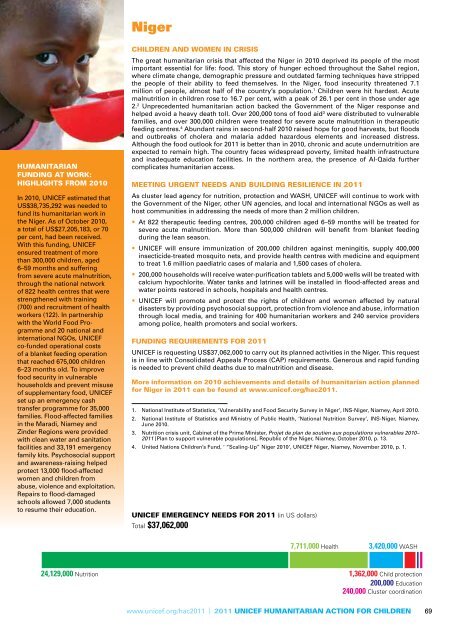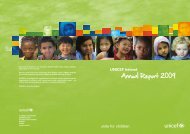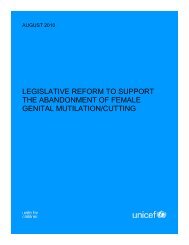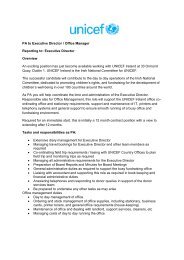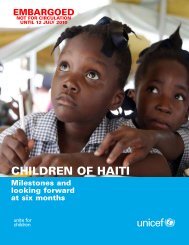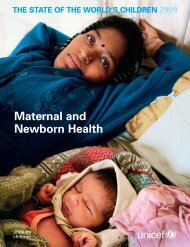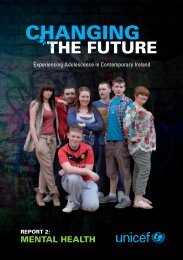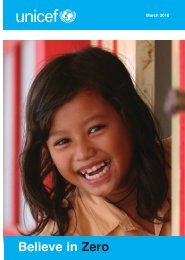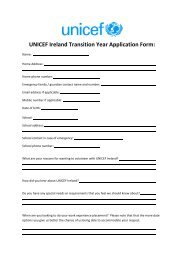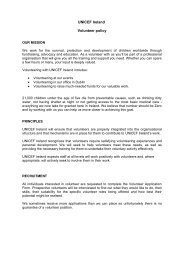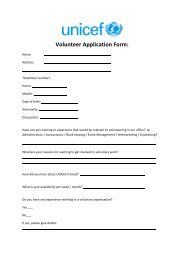Humanitarian Action for Children 2011 - Unicef
Humanitarian Action for Children 2011 - Unicef
Humanitarian Action for Children 2011 - Unicef
- No tags were found...
Create successful ePaper yourself
Turn your PDF publications into a flip-book with our unique Google optimized e-Paper software.
Niger<strong>Humanitarian</strong>funding at work:Highlights from 2010In 2010, UNICEF estimated thatUS$38,735,292 was needed tofund its humanitarian work inthe Niger. As of October 2010,a total of US$27,205,183, or 70per cent, had been received.With this funding, UNICEFensured treatment of morethan 300,000 children, aged6–59 months and sufferingfrom severe acute malnutrition,through the national networkof 822 health centres that werestrengthened with training(700) and recruitment of healthworkers (122). In partnershipwith the World Food Programmeand 20 national andinternational NGOs, UNICEFco-funded operational costsof a blanket feeding operationthat reached 675,000 children6–23 months old. To improvefood security in vulnerablehouseholds and prevent misuseof supplementary food, UNICEFset up an emergency cashtransfer programme <strong>for</strong> 35,000families. Flood-affected familiesin the Maradi, Niamey andZinder Regions were providedwith clean water and sanitationfacilities and 33,191 emergencyfamily kits. Psychosocial supportand awareness-raising helpedprotect 13,000 flood-affectedwomen and children fromabuse, violence and exploitation.Repairs to flood-damagedschools allowed 7,000 studentsto resume their education.<strong>Children</strong> and women in crisisThe great humanitarian crisis that affected the Niger in 2010 deprived its people of the mostimportant essential <strong>for</strong> life: food. This story of hunger echoed throughout the Sahel region,where climate change, demographic pressure and outdated farming techniques have strippedthe people of their ability to feed themselves. In the Niger, food insecurity threatened 7.1million of people, almost half of the country’s population. 1 <strong>Children</strong> were hit hardest. Acutemalnutrition in children rose to 16.7 per cent, with a peak of 26.1 per cent in those under age2. 2 Unprecedented humanitarian action backed the Government of the Niger response andhelped avoid a heavy death toll. Over 200,000 tons of food aid 3 were distributed to vulnerablefamilies, and over 300,000 children were treated <strong>for</strong> severe acute malnutrition in therapeuticfeeding centres. 4 Abundant rains in second-half 2010 raised hope <strong>for</strong> good harvests, but floodsand outbreaks of cholera and malaria added hazardous elements and increased distress.Although the food outlook <strong>for</strong> <strong>2011</strong> is better than in 2010, chronic and acute undernutrition areexpected to remain high. The country faces widespread poverty, limited health infrastructureand inadequate education facilities. In the northern area, the presence of Al-Qaida furthercomplicates humanitarian access.Meeting urgent needs and building resilience in <strong>2011</strong>As cluster lead agency <strong>for</strong> nutrition, protection and WASH, UNICEF will continue to work withthe Government of the Niger, other UN agencies, and local and international NGOs as well ashost communities in addressing the needs of more than 2 million children.• At 822 therapeutic feeding centres, 200,000 children aged 6–59 months will be treated <strong>for</strong>severe acute malnutrition. More than 500,000 children will benefit from blanket feedingduring the lean season.• UNICEF will ensure immunization of 200,000 children against meningitis, supply 400,000insecticide-treated mosquito nets, and provide health centres with medicine and equipmentto treat 1.6 million paediatric cases of malaria and 1,500 cases of cholera.• 200,000 households will receive water-purification tablets and 5,000 wells will be treated withcalcium hypochlorite. Water tanks and latrines will be installed in flood-affected areas andwater points restored in schools, hospitals and health centres.• UNICEF will promote and protect the rights of children and women affected by naturaldisasters by providing psychosocial support, protection from violence and abuse, in<strong>for</strong>mationthrough local media, and training <strong>for</strong> 400 humanitarian workers and 240 service providersamong police, health promoters and social workers.Funding requirements <strong>for</strong> <strong>2011</strong>UNICEF is requesting US$37,062,000 to carry out its planned activities in the Niger. This requestis in line with Consolidated Appeals Process (CAP) requirements. Generous and rapid fundingis needed to prevent child deaths due to malnutrition and disease.More in<strong>for</strong>mation on 2010 achievements and details of humanitarian action planned<strong>for</strong> Niger in <strong>2011</strong> can be found at www.unicef.org/hac<strong>2011</strong>.1. National Institute of Statistics, ‘Vulnerability and Food Security Survey in Niger’, INS-Niger, Niamey, April 2010.2. National Institute of Statistics and Ministry of Public Health, ‘National Nutrition Survey’, INS-Niger, Niamey,June 2010.3. Nutrition crisis unit, Cabinet of the Prime Minister, Projet de plan de soutien aux populations vulnerables 2010–<strong>2011</strong> [Plan to support vulnerable populations], Republic of the Niger, Niamey, October 2010, p. 13.4. United Nations <strong>Children</strong>’s Fund, ‘ “Scaling-Up” Niger 2010‘, UNICEF Niger, Niamey, November 2010, p. 1.UNICEF EMERGENCY NEEDS FOR <strong>2011</strong> (in US dollars)Total $37,062,0007,711,000 Health 3,420,000 WASH24,129,000 Nutrition 1,362,000 Child protection200,000 Education240,000 Cluster coordinationNigerwww.unicef.org/hac<strong>2011</strong> | <strong>2011</strong> UNICEF <strong>Humanitarian</strong> <strong>Action</strong> FOR CHILDREN 69


